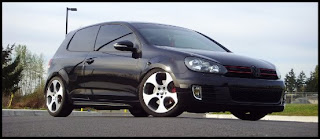
Auto Trader Ten Point Test rating: 83%
The Volkswagen Passat is a well thought of car, offering plenty of ability in an affordable, reasonably fun to drive and practical package. It does, however lack the style of some of its rivals.
1. Looks
Stunning. Although it's immediately recognisable as a Volkswagen Passat, the CC is longer, wider and lower than the saloon version for a more distinctive appearance. The most radical part of the car's design are its sides, which feature a curving arch between the front and rear windscreen pillars and give the car its sleek looks. Open the doors, and the windows are free from the clutter of frames. While the front is typically Volkswagen, albeit with a bolder grille and badge, the rear is a new departure for VW, with its unusually-shaped light clusters.
10/10
2. Looks inside
Volkswagen Passat owners will find some familiarity, in the front at least, with a standard Passat dash being brought up-to-date with some trinkets inspired by the Volkswagen Phaeton luxury saloon. The Passat CC marks a change for Volkswagen, with the trademark blue and red illumination replaced by white lights. The rear houses just two seats, separated by an armrest and storage space, and are very comfortable, and can be heated.
8/10
3. Practicality
The Volkswagen Passat CC's boot measures a useful 532 litres; impressive, especially as there's a full-sized spare wheel hidden underneath the carpet. Access is hampered by a small bootlid area – turning the handsome coupe into a hatchback shouldn't have meant sacrificing looks, but would have made it far more practical. Four seats will limit the appeal for some buyers too, and rear headroom in the rear isn't the best, but shoulder and legroom is very good. There's plenty of room in all directions for front seat occupants. And despite the frameless windows, the Passat CC is very refined, free from excessive wind and road noise.
7/10
4. Ride and Handling
Despite the Passat CC's flowing lines, it is not a sports car; more a long distance budget GT cruiser. It rides superbly, and buyers can specify the Adaptive Chassis Control, which firms up the suspension through three modes, to turn it into a more focused drivers' car. It lacks the outright driving engagement of the BMW 3 Series or Ford Mondeo, but is still capable of entertaining. The steering is light at low speeds, but adds weight as the speed increases, although it lacks the ultimate level of communication of the best in class. The range-topping GT V6 features Volkswagen's excellent 4Motion four-wheel drive system for added grip.
8/10
5. Performance
Three petrol and two diesel engines are available in the Volkswagen Passat CC: a 1.8, 2-litre and 3.6-litre V6 petrol and a pair of 2-litre diesels. The 1.8, 2-litre and 3.6 V6 offer 0-62mph times of 8.6, 7.6 and 5.6 seconds respectively, with top speeds of 138, 147 and 155mph. The diesels – which are both 2-litre engines, producing 140 and 170bhp – cover the same marker in 9.8 and 8.6 seconds, before reaching 130 and 141mph. Volkswagen's excellent DSG semi-automatic gearbox is available on all models.
8/10
View our Volkswagen Passat CC slide show
6. Running Costs
The 140bhp 2-litre diesel version we tested returned up to 55mpg on a mixture of fast motorway and congested urban driving. That's almost exactly what Volkswagen claims it to be, and achieved without concentrating on efficient driving. The Passat CC is around £3-4,000 more expensive than the standard saloon model, but all models in the sleek coupe range hold their value better than the saloon and estate versions. Emissions of 153g/km place both diesels in tax band D, which currently costs £144 per year, while emissions of 180, 193 and 242g/km place the petrol engined 1.8, 2-litre and 3.6 in bands E (£170), F (£210) and G (£400) respectively.
8/10
7. Reliability
Despite the radically different looks of the Passat CC over the standard car, it shares 55 per cent of parts. That means the technology is proven, and should raise little cause for concern.
8/10
8. Safety
The standard Volkswagen Passat scored a full five star rating for adult occupant protection in the EuroNCAP crash tests, and it's likely the Passat CC will score likewise. Standard safety equipment includes ABS with brake assist and brake force distribution, driver, passenger, front side and curtain airbags, ESP and whiplash reducing headrests.
9/10
9. Equipment
With Volkswagen's premium pricing comes a good level of standard equipment. The base model features a touch-screen radio with MP3-compatible CD player and a 6 CD autochanger; 17-inch alloys, two zone climate control, electrically operated driver's seat, electrically heated and adjustable door mirrors, an auto-dimming rear view mirror and a cooled glovebox. The GT model adds 18-inch alloys, front fog lights, brushed aluminium dash inserts and Adaptive Chassis Control (see Ride and Handling). The GT V6 model also receives a leather interior, heated front seats and electronic tyre pressure monitoring.
8/10
10. X-Factor
The Volkswagen Passat CC takes all that's great about the standard car and puts it in a body which turns heads like few other VWs.
9/10
Model tested: Volkswagen Passat CC GT 2-litre CR 140PS 6sp manual
Price as tested: £22,795 (£21,065 - £31,145)
Insurance group as tested: 11E (11E – 18E)
CO2 emissions as tested: 153g/km (Band D, £145)
CO2 emissions range: 153-242g/km
Company car tax %: 21%
EuroNCAP result: N/A
Date tested: September 2008
Road tester: Stuart Milne


